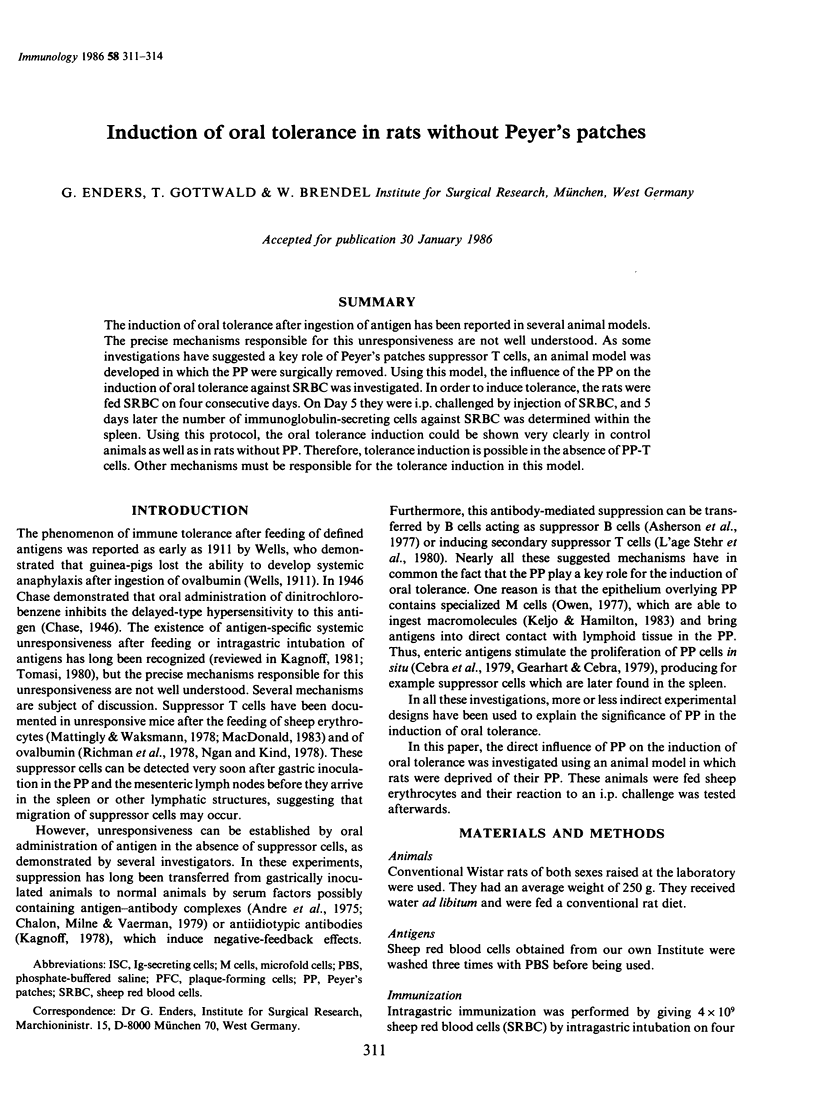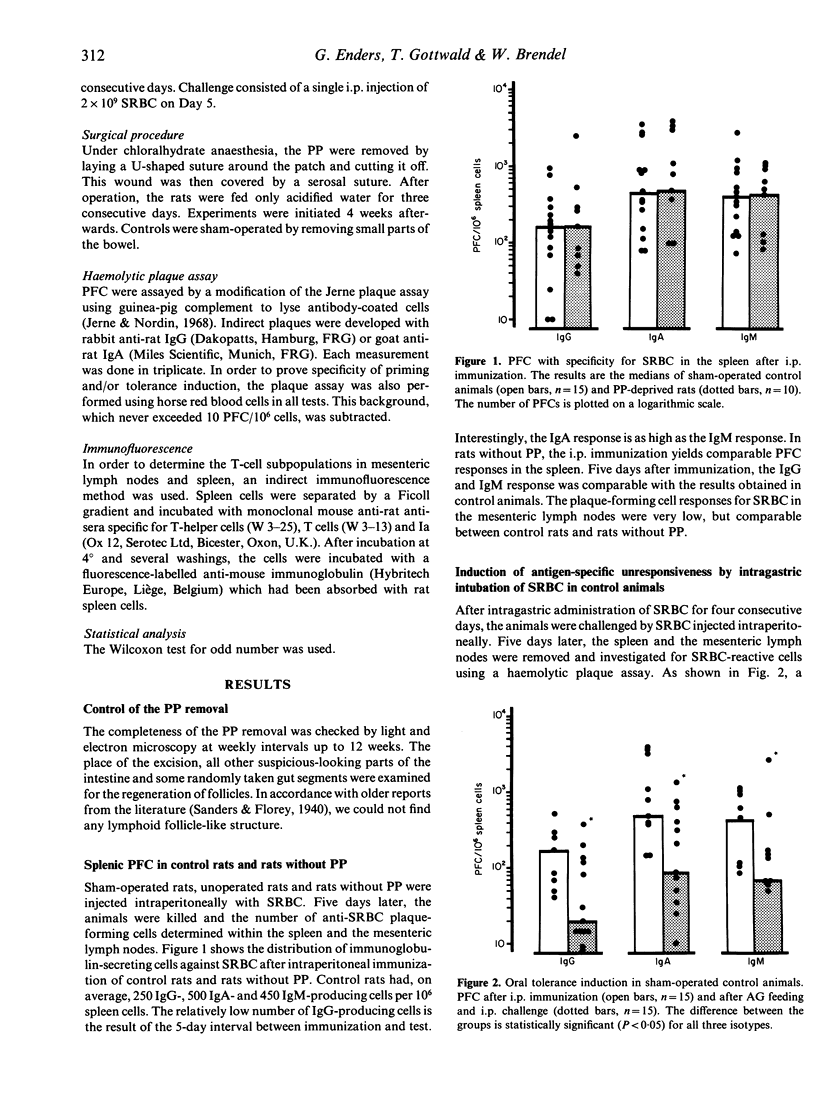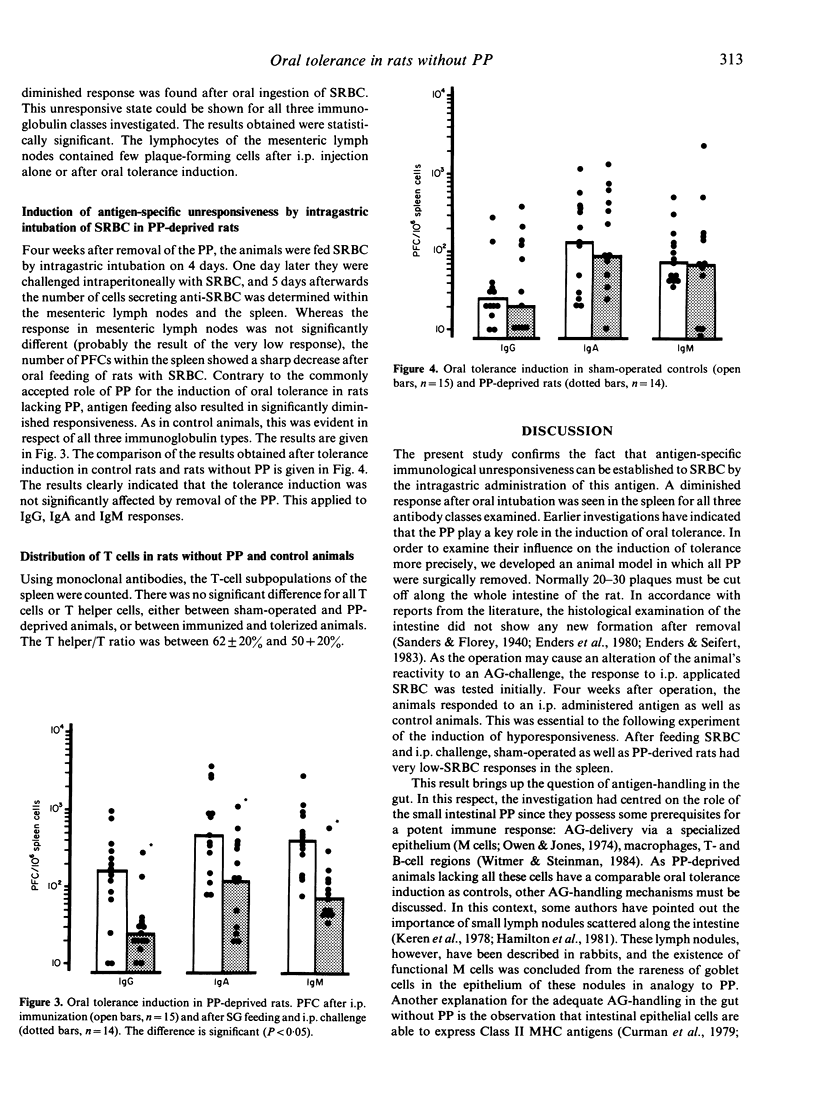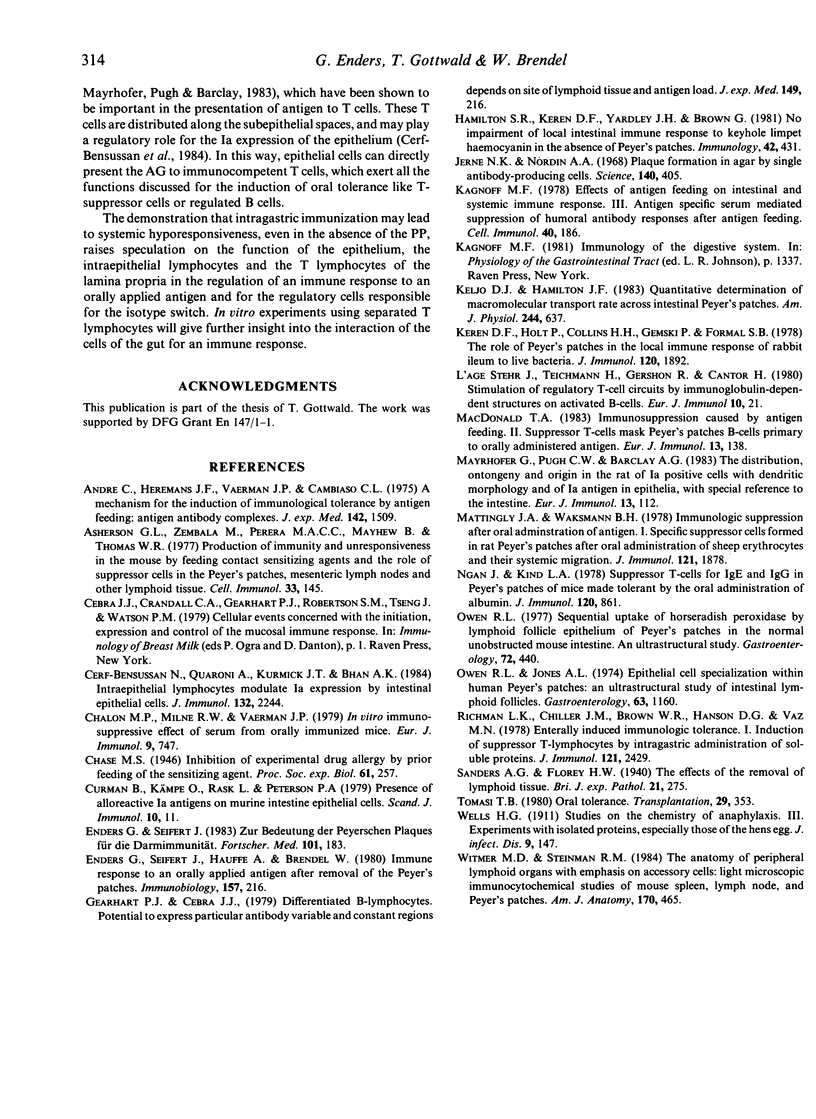Abstract
The induction of oral tolerance after ingestion of antigen has been reported in several animal models. The precise mechanisms responsible for this unresponsiveness are not well understood. As some investigations have suggested a key role of Peyer's patches suppressor T cells, an animal model was developed in which the PP were surgically removed. Using this model, the influence of the PP on the induction of oral tolerance against SRBC was investigated. In order to induce tolerance, the rats were fed SRBC on four consecutive days. On Day 5 they were i.p. challenged by injection of SRBC, and 5 days later the number of immunoglobulin-secreting cells against SRBC was determined within the spleen. Using this protocol, the oral tolerance induction could be shown very clearly in control animals as well as in rats without PP. Therefore, tolerance induction is possible in the absence of PP-T cells. Other mechanisms must be responsible for the tolerance induction in this model.
Full text
PDF



Selected References
These references are in PubMed. This may not be the complete list of references from this article.
- André C., Heremans J. F., Vaerman J. P., Cambiaso C. L. A mechanism for the induction of immunological tolerance by antigen feeding: antigen-antibody complexes. J Exp Med. 1975 Dec 1;142(6):1509–1519. doi: 10.1084/jem.142.6.1509. [DOI] [PMC free article] [PubMed] [Google Scholar]
- Asherson G. L., Zembala M., Perera M. A., Mayhew B., Thomas W. R. Production of immunity and unresponsiveness in the mouse by feeding contact sensitizing agents and the role of suppressor cells in the peyer's patches, mesenteric lymph nodes and other lymphoid tissues. Cell Immunol. 1977 Sep;33(1):145–155. doi: 10.1016/0008-8749(77)90142-3. [DOI] [PubMed] [Google Scholar]
- Cerf-Bensussan N., Quaroni A., Kurnick J. T., Bhan A. K. Intraepithelial lymphocytes modulate Ia expression by intestinal epithelial cells. J Immunol. 1984 May;132(5):2244–2252. [PubMed] [Google Scholar]
- Chalon M. P., Milne R. W., Vaerman J. P. In vitro immunosuppressive effect of serum from orally immunized mice. Eur J Immunol. 1979 Oct;9(10):747–751. doi: 10.1002/eji.1830091002. [DOI] [PubMed] [Google Scholar]
- Curman B., Kämpe O., Rask L., Peterson P. A. Presence of alloreactive Ia antigens on murine intestine epithelial cells. Scand J Immunol. 1979;10(1):11–15. doi: 10.1111/j.1365-3083.1979.tb01328.x. [DOI] [PubMed] [Google Scholar]
- Gearhart P. J., Cebra J. J. Differentiated B lymphocytes. Potential to express particular antibody variable and constant regions depends on site of lymphoid tissue and antigen load. J Exp Med. 1979 Jan 1;149(1):216–227. doi: 10.1084/jem.149.1.216. [DOI] [PMC free article] [PubMed] [Google Scholar]
- Hamilton S. R., Keren D. F., Yardley J. H., Brown G. No impairment of local intestinal immune response to keyhole limpet haemocyanin in the absence of Peyer's patches. Immunology. 1981 Mar;42(3):431–435. [PMC free article] [PubMed] [Google Scholar]
- Jerne N. K., Nordin A. A. Plaque Formation in Agar by Single Antibody-Producing Cells. Science. 1963 Apr 26;140(3565):405–405. doi: 10.1126/science.140.3565.405. [DOI] [PubMed] [Google Scholar]
- Kagnoff M. F. Effects of antigen-feeding on intestinal and systemic immune responses. III. Antigen-specific serum-mediated suppression of humoral antibody responses after antigen feeding. Cell Immunol. 1978 Sep 15;40(1):186–203. doi: 10.1016/0008-8749(78)90326-x. [DOI] [PubMed] [Google Scholar]
- Keren D. F., Holt P. S., Collins H. H., Gemski P., Formal S. B. The role of Peyer's patches in the local immune response of rabbit ileum to live bacteria. J Immunol. 1978 Jun;120(6):1892–1896. [PubMed] [Google Scholar]
- MacDonald T. T. Immunosuppression caused by antigen feeding II. Suppressor T cells mask Peyer's patch B cell priming to orally administered antigen. Eur J Immunol. 1983 Feb;13(2):138–142. doi: 10.1002/eji.1830130209. [DOI] [PubMed] [Google Scholar]
- Mattingly J. A., Waksman B. H. Immunologic suppression after oral administration of antigen. I. Specific suppressor cells formed in rat Peyer's patches after oral administration of sheep erythrocytes and their systemic migration. J Immunol. 1978 Nov;121(5):1878–1883. [PubMed] [Google Scholar]
- Mayrhofer G., Pugh C. W., Barclay A. N. The distribution, ontogeny and origin in the rat of Ia-positive cells with dendritic morphology and of Ia antigen in epithelia, with special reference to the intestine. Eur J Immunol. 1983 Feb;13(2):112–122. doi: 10.1002/eji.1830130206. [DOI] [PubMed] [Google Scholar]
- Ngan J., Kind L. S. Suppressor T cells for IgE and IgG in Peyer's patches of mice made tolerant by the oral administration of ovalbumin. J Immunol. 1978 Mar;120(3):861–865. [PubMed] [Google Scholar]
- Owen R. L. Sequential uptake of horseradish peroxidase by lymphoid follicle epithelium of Peyer's patches in the normal unobstructed mouse intestine: an ultrastructural study. Gastroenterology. 1977 Mar;72(3):440–451. [PubMed] [Google Scholar]
- Richman L. K., Chiller J. M., Brown W. R., Hanson D. G., Vaz N. M. Enterically induced immunologic tolerance. I. Induction of suppressor T lymphoyctes by intragastric administration of soluble proteins. J Immunol. 1978 Dec;121(6):2429–2434. [PubMed] [Google Scholar]
- Tomasi T. B., Jr Oral tolerance. Transplantation. 1980 May;29(5):353–356. doi: 10.1097/00007890-198005000-00001. [DOI] [PubMed] [Google Scholar]
- Witmer M. D., Steinman R. M. The anatomy of peripheral lymphoid organs with emphasis on accessory cells: light-microscopic immunocytochemical studies of mouse spleen, lymph node, and Peyer's patch. Am J Anat. 1984 Jul;170(3):465–481. doi: 10.1002/aja.1001700318. [DOI] [PubMed] [Google Scholar]


